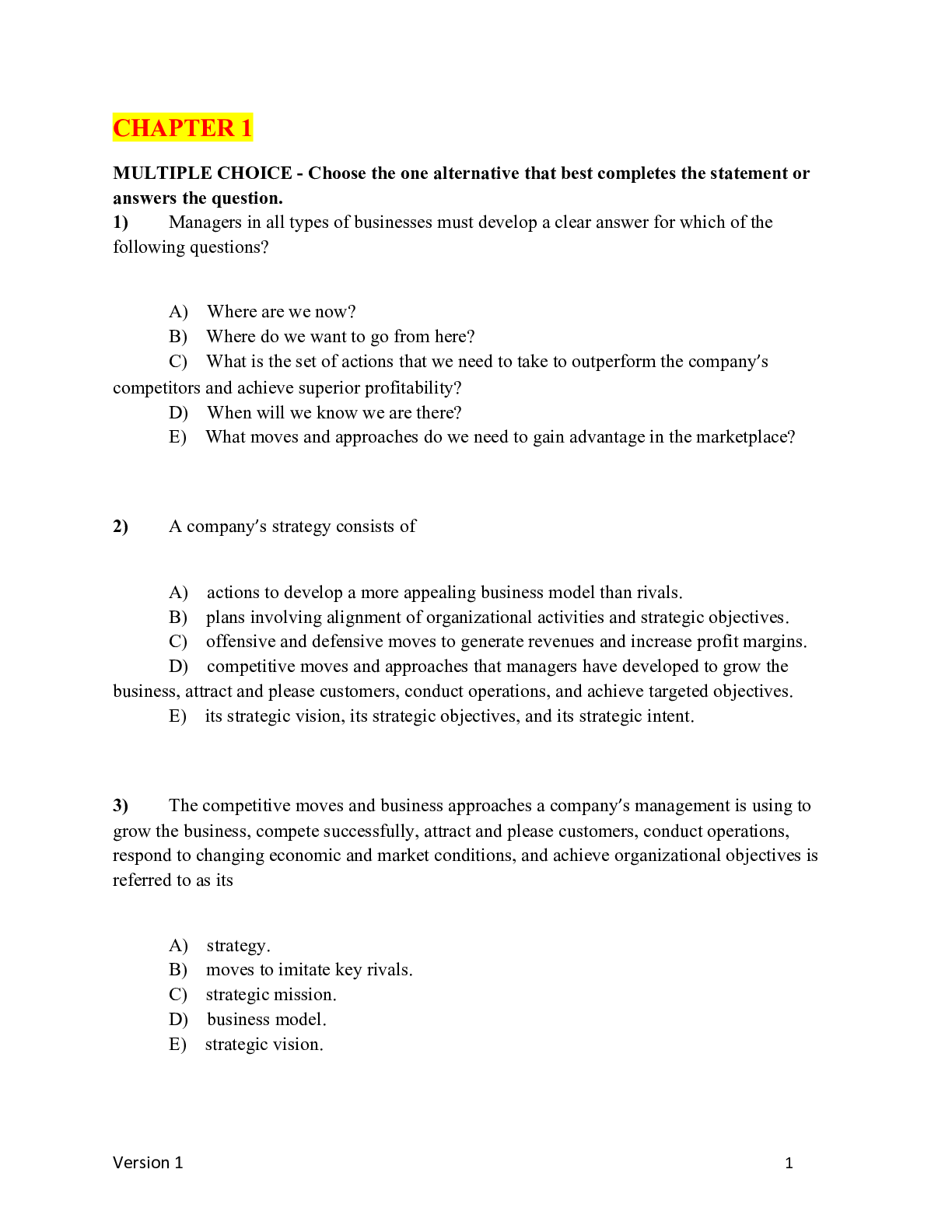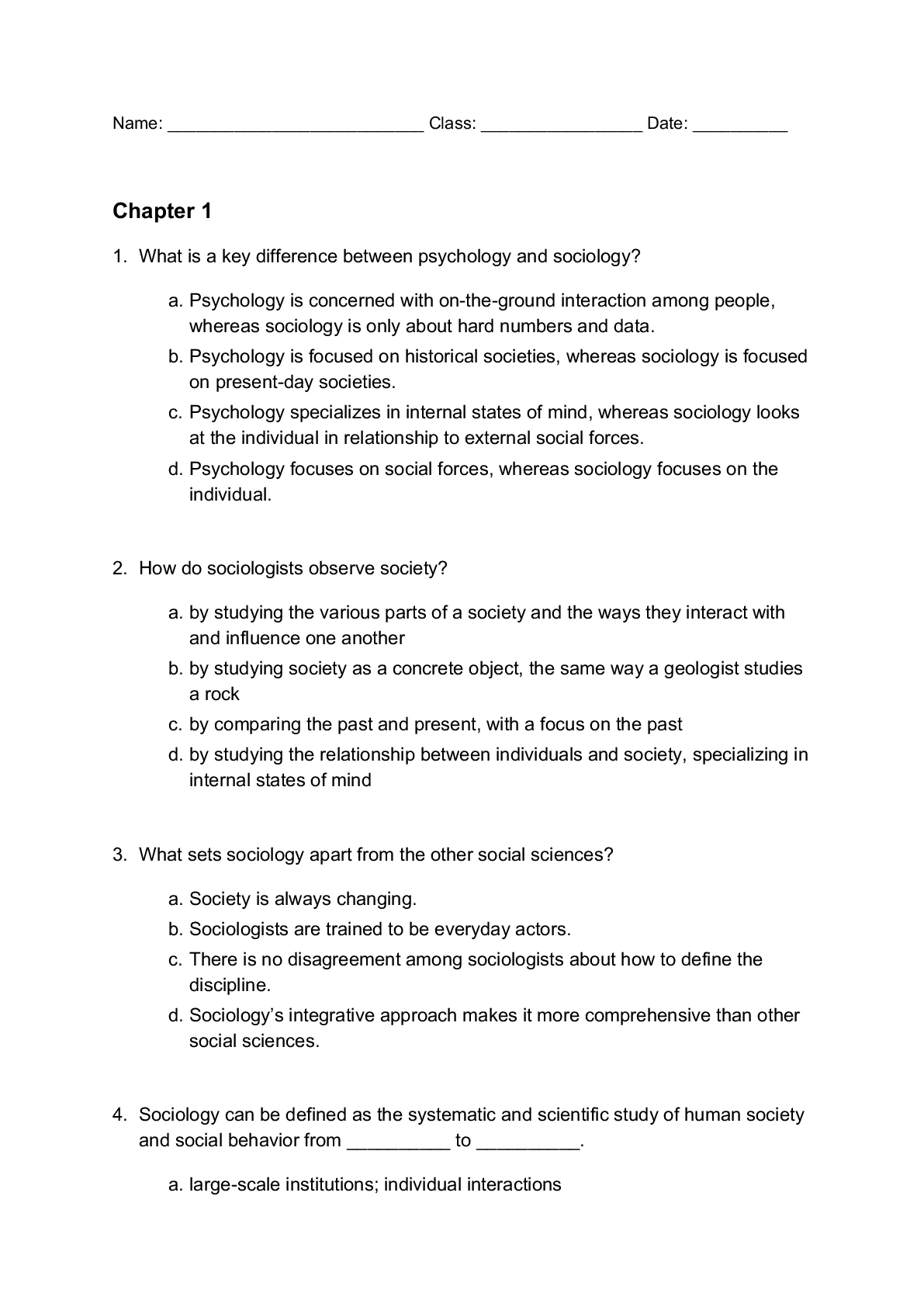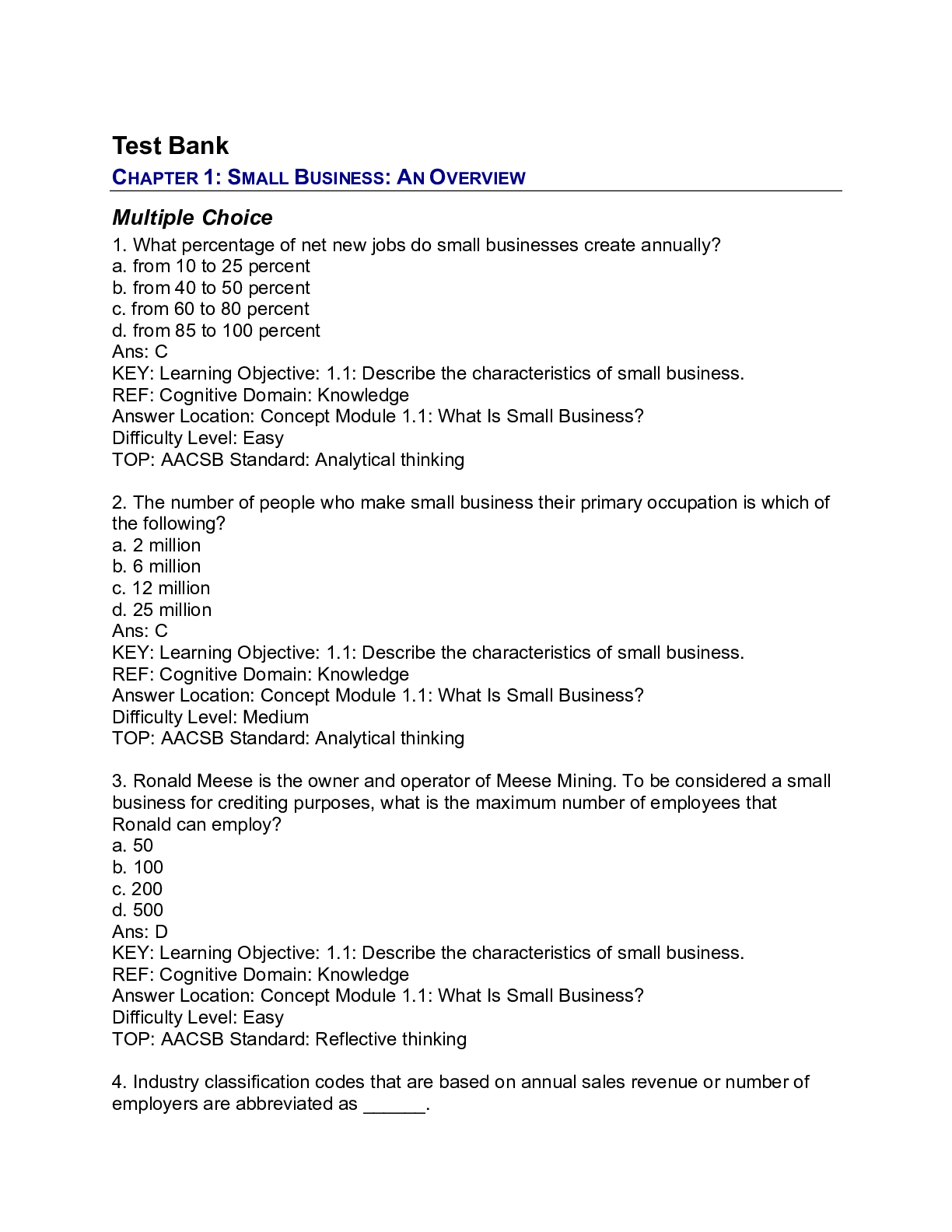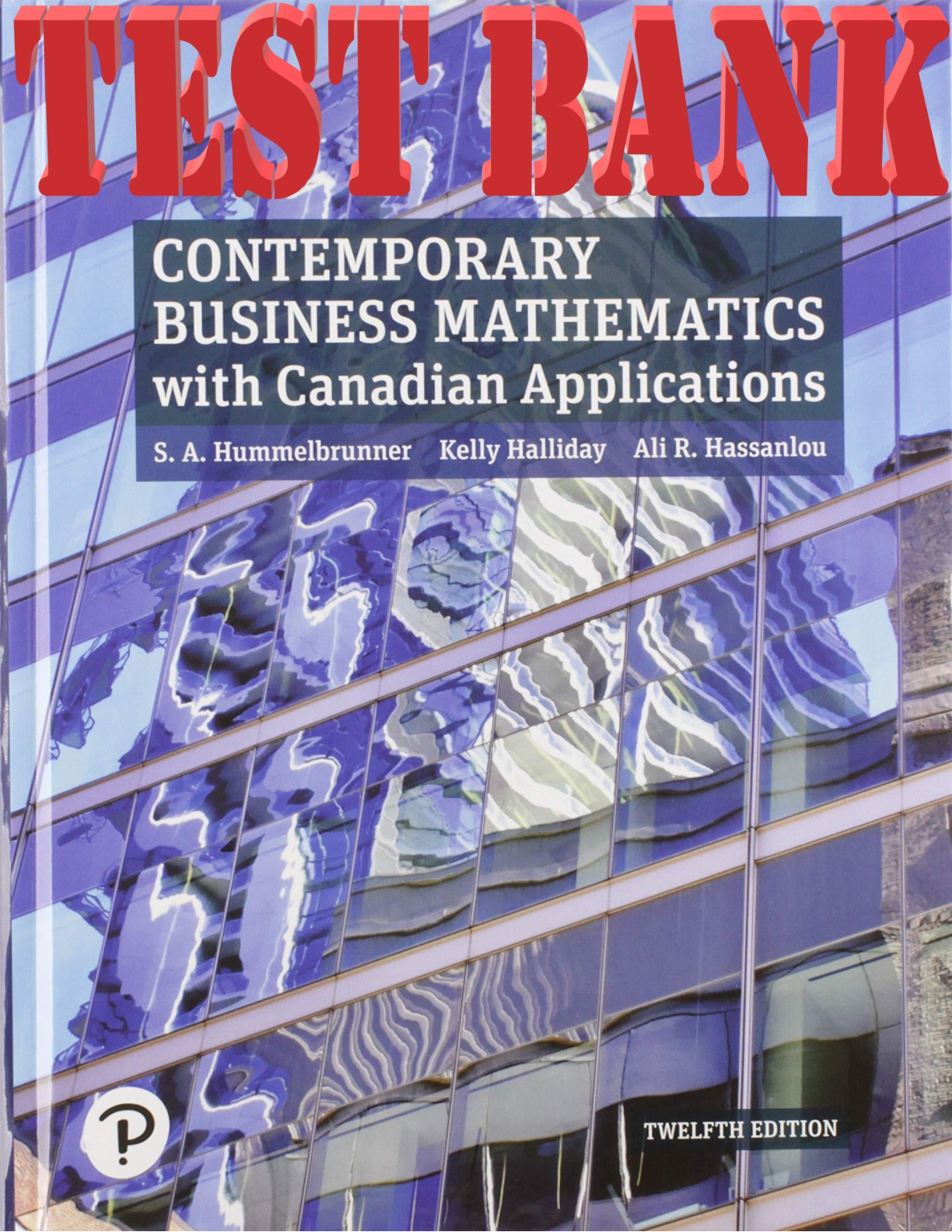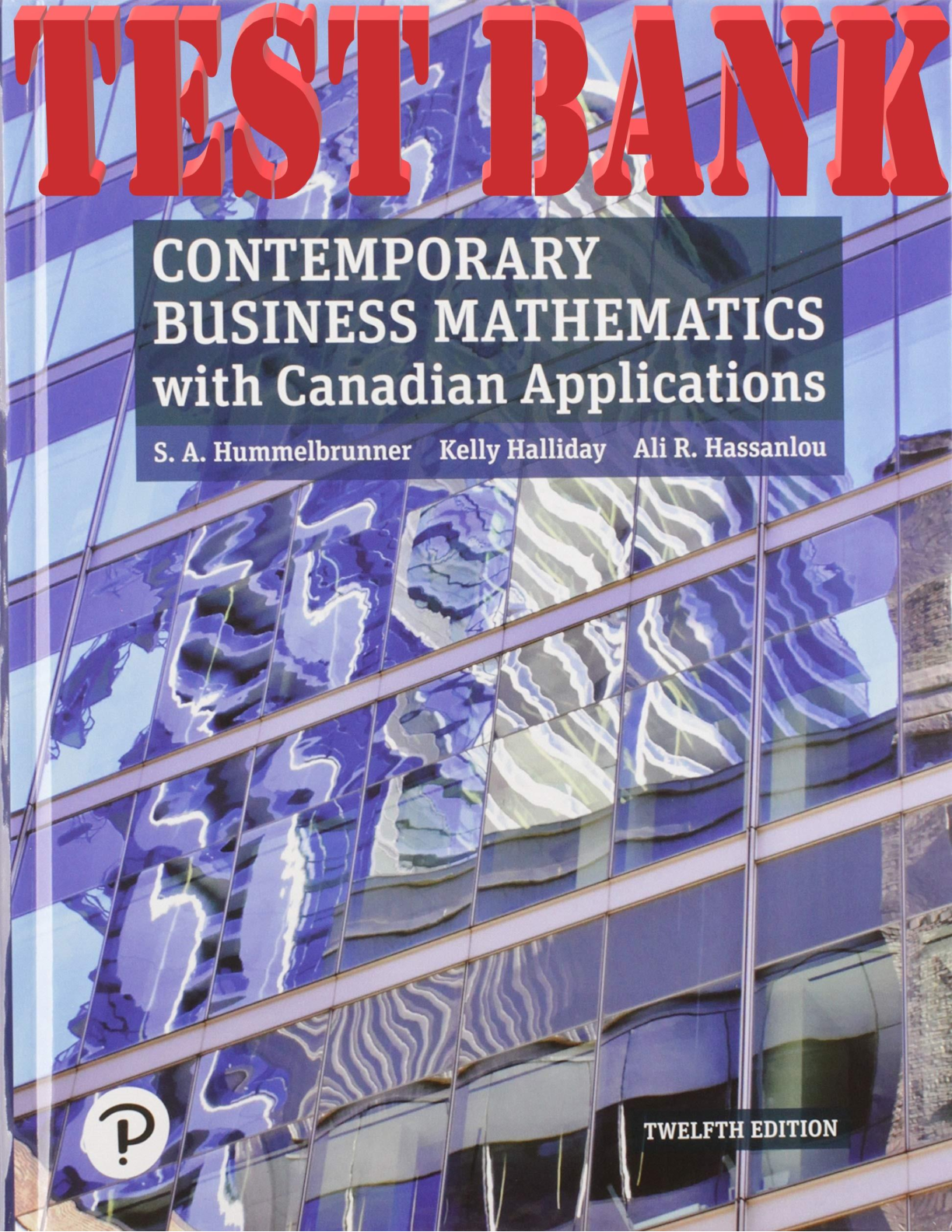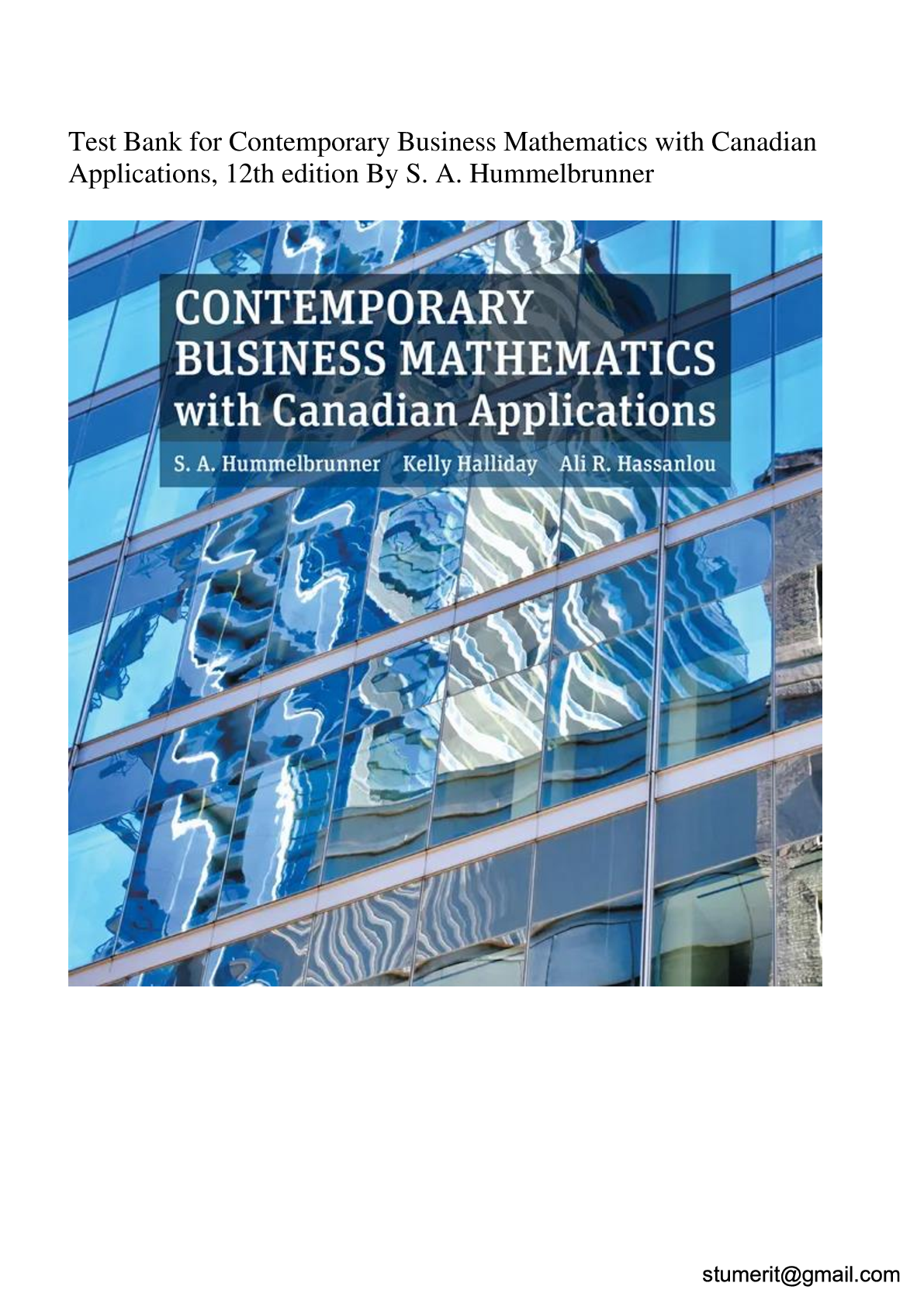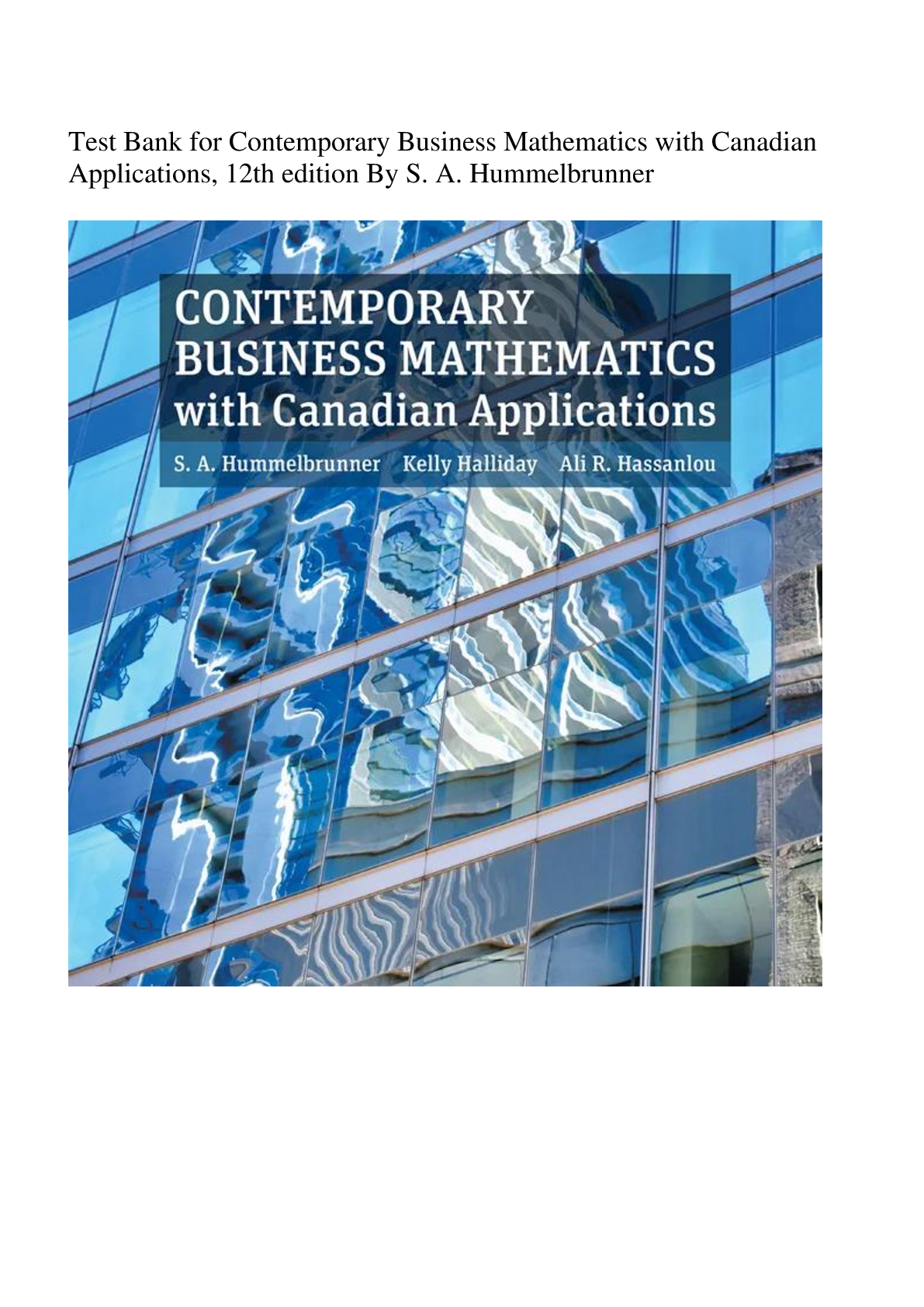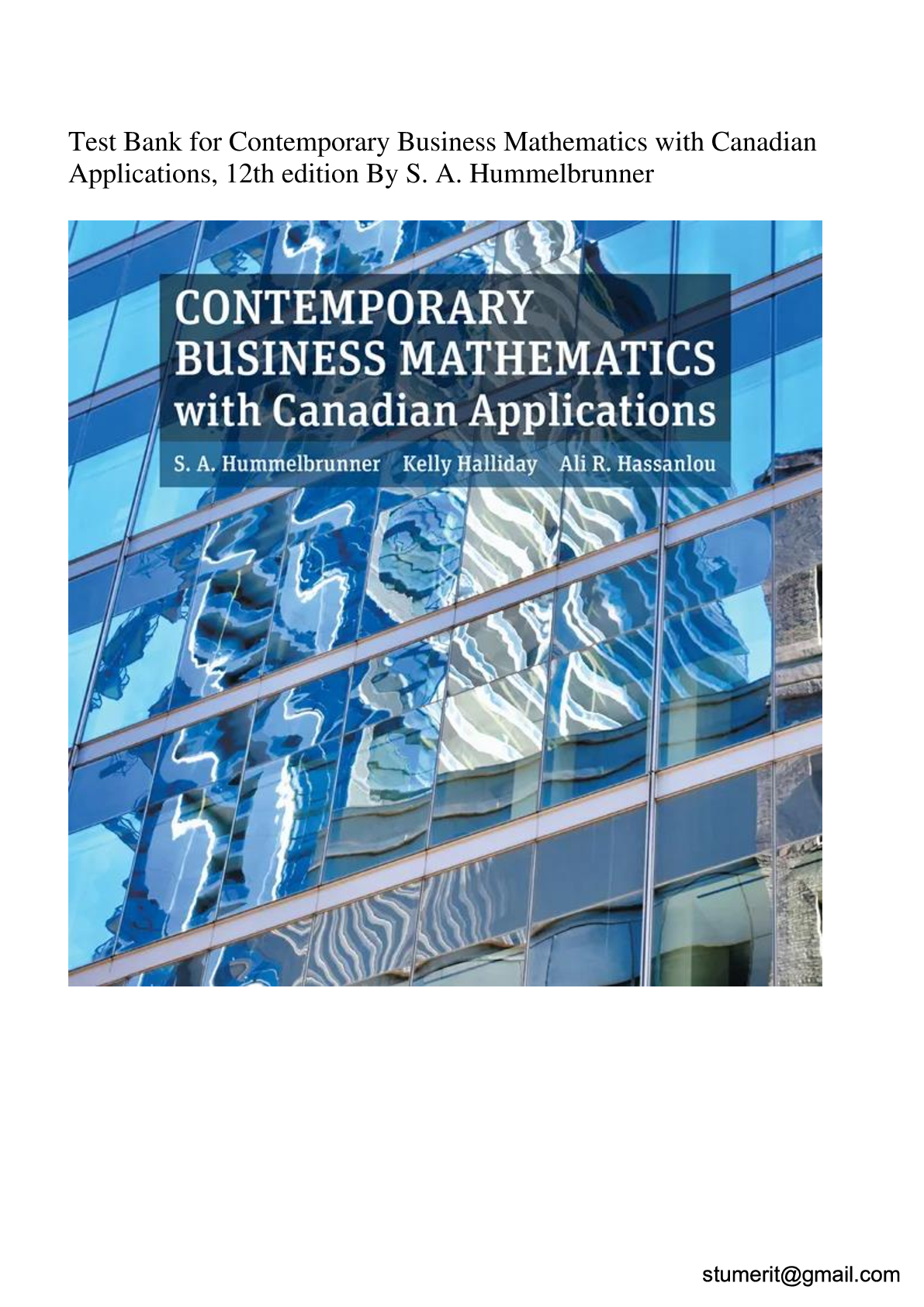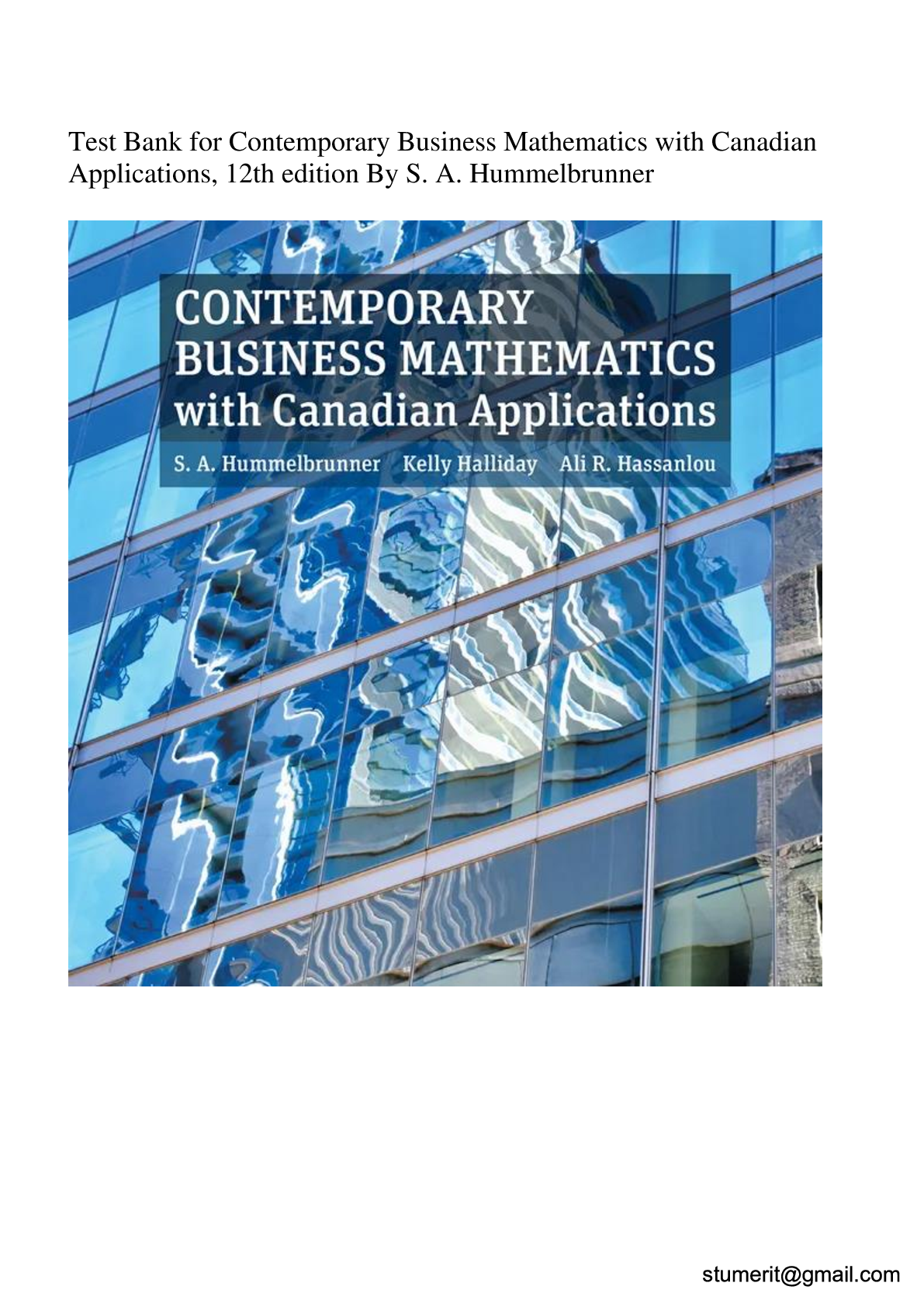Mathematics > TEST BANKS > TEST BANK for Contemporary Business Mathematics with Canadian Applications, 12th Canadian Edition by (All)
TEST BANK for Contemporary Business Mathematics with Canadian Applications, 12th Canadian Edition by Sieg Hummel, Brunner
Document Content and Description Below
Test Bank for Contemporary Business Mathematics with Canadian Applications, 12th Canadian Edition, 12ce by Sieg A. Hummelbrunner, K Suzanne Coombs TEST BANK ISBN-13: 9780135405871 Full chapters inc... luded Chapter 1 Review of Arithmetic Chapter 1 Review of Arithmetic Introduction 1.1 Basics of Arithmetic Exercise 1.1 1.2 Fractions B. Equivalent fractions C. Converting common fractions into decimal form D. Converting mixed numbers to decimal form E. Rounding F. Complex fractions Exercise 1.2 1.3 Percent B. Changing percents to common fractions C. Changing percents to decimals D. Changing decimals to percents E. Changing fractions to percents Exercise 1.3 1.4 Applications—Averages B. Problems involving simple arithmetic average C. Weighted average Exercise 1.4 1.5 Applications—Payroll B. Commission C. Wages Exercise 1.5 1.6 Applications—Taxes B. Property tax Exercise 1.6 Review Exercise Self-Test Challenge Problems Case Study Businesses and the GST/HST Questions Glossary Chapter 2 Review of Basic Algebra Chapter 2 Review of Basic Algebra Introduction 2.1 Simplification of Algebraic Expressions B. Multiplication C. Division D. Substitution and evaluation Exercise 2.1 2.2 Integral Exponents B. Numerical evaluation of powers with positive integral exponents C. Operations with powers D. Zero exponent E. Negative exponents Exercise 2.2 2.3 Fractional Exponents B. Fractional exponents Exercise 2.3 2.4 Logarithms—Basic Aspects B. Common logarithms C. Natural logarithms D. Useful relationships Exercise 2.4 2.5 Solving Basic Equations B. Solving equations using addition C. Solving equations using subtraction D. Solving equations using multiplication E. Solving equations using division F. Using two or more operations to solve equations G. Checking equations Exercise 2.5 2.6 Solving Equations Involving Algebraic Simplification B. Solving linear equations containing common fractions C. Solving linear equations involving fractional constants and multiplication D. Formula rearrangement Exercise 2.6 2.7 Solving Word Problems Exercise 2.7 Review Exercise Self-Test Challenge Problems Case Study Investing in a Tax-Free Savings Account Questions Summary of Formulas Glossary Chapter 3 Ratio, Proportion, and Percent Chapter 3 Ratio, Proportion, and Percent Introduction 3.1 Ratios B. Reducing ratios to lowest terms C. Equivalent ratios in higher terms D. Allocation according to a ratio Exercise 3.1 3.2 Proportions B. Problems involving proportions Exercise 3.2 3.3 The Basic Percentage Problem B. Computation with commonly used percents C. Calculating the base D. Calculating a percentage rate E. Applications Exercise 3.3 3.4 Problems Involving Increase or Decrease B. Calculating the rate of increase or decrease C. Determining the original amount Exercise 3.4 3.5 Problems Involving Percent B. Problems involving the computation of a percentage rate C. Problems involving the basic percentage relationship D. Problems of increase or decrease Exercise 3.5 3.6 Applications—Currency Conversions B. Using cross rate tables Exercise 3.6 3.7 Applications—Index Numbers B. The Consumer Price Index and its uses Exercise 3.7 3.8 Applications—Personal Income Taxes Exercise 3.8 Review Exercise Self-Test Challenge Problems Case Study The Business of Taxes Questions Summary of Formulas Glossary Chapter 4 Linear Systems Chapter 4 Linear Systems Introduction 4.1 Graphing Linear Equations B. Graphing in a system of rectangular coordinates C. Constructing a table of values D. Graphing linear equations E. Special cases—lines parallel to the axes F. The slope–y-intercept form of a linear equation G. Special cases of the slope–y-intercept form of a linear equation Exercise 4.1 4.2 Graphing Linear Systems of Equations in Two Variables Exercise 4.2 4.3 Algebraic Solution of Systems of Linear Equations in Two Variables B. Solving a system of two linear equations by algebraic substitution C. Solving linear systems in two variables involving fractions D. Systems of two linear equations with no solution or many solutions Exercise 4.3 4.4 Problem Solving B. Problems leading to systems of equations Exercise 4.4 4.5 Graphing Inequalities B. Graphing inequalities of the form ax + by > c and ax + by < c C. Graphing inequalities of the form ax > by or ax < by D. Graphing inequalities involving lines parallel to the axes E. Graphing systems of linear inequalities Exercise 4.5 4.6 Problem Solving B. Problems leading to systems of linear inequalities in two variables Review Exercise Self-Test Challenge Problems Case Study Determining the Right Combination Questions Summary of Formulas Glossary Part 1 Comprehensive Case Til Debt Do Us Part Part 2 Mathematics of Business and Management Introduction: Part 2 Chapter 5 Cost-Volume-Profit Analysis and Break-Even Chapter 5 Cost-Volume-Profit Analysis and Break-Even Introduction 5.1 Cost-Volume-Profit Analysis and Break-Even Charts B. Break-even charts C. Computing break-even using formulas D. Calculating break-even when the unit prices and unit costs are unknown Exercise 5.1 5.2 Contribution Margin and Contribution Rate B. Contribution rate Exercise 5.2 5.3 Effects of Changes to Cost-Volume-Profit Exercise 5.3 Review Exercise Self-Test Challenge Problems Case Study Segway Tours Questions Summary of Formulas Glossary Chapter 6 Trade Discounts, Cash Discounts, Markup, and Markdown Chapter 6 Trade Discounts, Cash Discounts, Markup, and Markdown Introduction 6.1 Determining Cost with Trade Discounts B. The net price factor approach C. Discount series D. Single equivalent rates of discount Exercise 6.1 6.2 Payment Terms and Cash Discounts B. Ordinary dating C. End-of-the-month dating D. Receipt-of-goods dating E. Partial payments and additional problems Exercise 6.2 6.3 Markup B. Rate of markup C. Calculating the cost or the selling price Exercise 6.3 6.4 Markdown B. Concepts and calculations Exercise 6.4 6.5 Integrated Problems Exercise 6.5 Review Exercise Self-Test Challenge Problems Case Study Focusing on Prices Questions Summary of Formulas Glossary Chapter 7 Simple Interest Chapter 7 Simple Interest Introduction 7.1 Calculating the Amount of Simple Interest B. Matching r and t C. Computing the amount of interest D. Using Excel’s ACCRINT Exercise 7.1 7.2 Calculating the Principal, Rate, or Time B. Calculating the principal C. Calculating the rate D. Calculating the time Exercise 7.2 7.3 Computing Future Value (Maturity Value) B. The future value formula S = P (1 + rt) Exercise 7.3 7.4 Calculating the Principal (Present Value) Exercise 7.4 7.5 Computing Equivalent Values B. Choosing the appropriate formula C. Calculating the equivalent single payment D. Calculating the value of two or more equivalent payments E. Loan repayments Exercise 7.5 Review Exercise Self-Test Challenge Problems Case Study Cost of Financing: Pay Now or Pay Later Questions Summary of Formulas Glossary Chapter 8 Simple Interest Applications Chapter 8 Simple Interest Applications Introduction 8.1 Promissory Notes B. Maturity value of interest-bearing promissory notes C. Present value of promissory notes D. Using Excel’s ACCRINTM Exercise 8.1 8.2 Treasury Bills and Commercial Paper B. Commercial paper Exercise 8.2 8.3 Demand Loans Exercise 8.3 8.4 Lines of Credit and Simple Interest Loans Exercise 8.4 8.5 Loan Repayment Schedules B. Construction of loan repayment schedules illustrated C. Computer application—loan repayment schedule Exercise 8.5 Review Exercise Self-Test Challenge Problems Case Study Debt Consolidation Questions Summary of Formulas Glossary Part 2 Comprehensive Case SportZ Ltd. Part 3 Mathematics of Finance and Investment Introduction: Part 3 Chapter 9 Compound Interest—Future Value and Present Value Chapter 9 Compound Interest—Future Value and Present Value Introduction 9.1 Basic Concepts and Calculations B. The future value formula for compound interest C. Determining the periodic rate of interest D. Determining the number of compounding periods in the term of an investment or loan E. Setting up the compounding factor (1 + i)n F. Calculating the numerical value of the compounding factor (1 + i)n Exercise 9.1 9.2 Using the Future Value Formula of a Compound Amount FV = PV (1 + i)n B. Using preprogrammed financial calculators C. Using Excel’s FV or PV D. Applications involving changes in interest rate Exercise 9.2 9.3 Present Value and Compound Discount B. The present value formula C. Using preprogrammed financial calculators to calculate present value Exercise 9.3 9.4 Application—Discounting Negotiable Financial Instruments at Compound Interest B. Discounting non-interest-bearing promissory notes C. Discounting interest-bearing promissory notes Exercise 9.4 9.5 Equivalent Values B. Calculating the equivalent single payment C. Determining the value of two or more equivalent replacement payments Exercise 9.5 Review Exercise Self-Test Challenge Problems Case Study Planning Ahead Questions Summary of Formulas Glossary Chapter 10 Compound Interest—Further Topics Chapter 10 Compound Interest—Further Topics Introduction 10.1 Determining n and Related Problems B. Equated date C. Using Excel’s NPER Exercise 10.1 10.2 Calculating i and Related Problems B. Using Excel’s RATE Function Exercise 10.2 10.3 Effective and Equivalent Interest Rates B. Equivalent rates C. Using Excel’s EFFECT Function Exercise 10.3 Review Exercise Self-Test Challenge Problems Case Study Comparing Car Loans Questions Summary of Formulas Glossary Chapter 11 Ordinary Simple Annuities Chapter 11 Ordinary Simple Annuities Introduction 11.1 Introduction to Annuities B. Types of annuities 11.2 Ordinary Simple Annuity—Calculating Future Value FV B. Formula for calculating the future value of an ordinary simple annuity C. Using preprogrammed financial calculators D. Applications Exercise 11.2 11.3 Ordinary Simple Annuity—Calculating Present Value PV B. Formula for calculating the present value of an ordinary simple annuity C. Present value using preprogrammed financial calculators D. Applications Exercise 11.3 11.4 Ordinary Simple Annuities—Determining the Periodic Payment PMT B. Determining the periodic payment PMT when the present value of an annuity is known C. Using Excel’s PMT Function Exercise 11.4 11.5 Determining the Term n of an Annuity B. Determining the term n when the present value of an annuity is known Exercise 11.5 11.6 Calculating the Periodic Rate of Interest i Using Preprogrammed Financial Calculators Exercise 11.6 Review Exercise Self-Test Challenge Problems Case Study Getting the Picture Questions Summary of Formulas Glossary Chapter 12 Ordinary General Annuities Chapter 12 Ordinary General Annuities Introduction 12.1 Ordinary General Annuities—Calculating the Future Value FV B. Relationship between payment interval and interest conversion period C. Computing the equivalent rate of interest per payment period D. Future value of an ordinary general annuity E. Using preprogrammed financial calculators to compute the future value of an ordinary general annuity Exercise 12.1 12.2 Ordinary General Annuities—Calculating the Present Value PV B. Using preprogrammed financial calculators to compute the present value of an ordinary general annuity Exercise 12.2 12.3 Ordinary General Annuities—Determining the Periodic Payment PMT B. Determining the periodic payment PMT when the present value of a general annuity is known Exercise 12.3 12.4 Ordinary General Annuities—Determining the Term n B. Determining the term n when the present value of a general annuity is known Exercise 12.4 12.5 Ordinary General Annuities—Calculating the Periodic Interest Rate i Exercise 12.5 12.6 Constant-Growth Annuities B. Present value of an ordinary simple constant-growth annuity Exercise 12.6 Review Exercise Self-Test Challenge Problems Case Study Vehicle Cash-Back Incentives Questions Summary of Formulas Glossary Chapter 13 Annuities Due, Deferred Annuities, and Perpetuities Chapter 13 Annuities Due, Deferred Annuities, and Perpetuities Introduction 13.1 Simple Annuities Due B. Using preprogrammed financial calculators C. Solving the terms PMT, n, and i of a simple annuity due when the FV is known D. Present value of a simple annuity due E. Solving the terms PMT, n, and i of a simple annuity due when the PV is known Exercise 13.1 13.2 General Annuities Due B. Solving the terms PMT, n, and i of a general annuity due when the FV is known C. Present value of a general annuity due D. Solving the terms PMT, n, and i of a general annuity due when the PV is known Exercise 13.2 13.3 Ordinary Deferred Annuities B. Computation of an ordinary general deferred annuity Exercise 13.3 13.4 Deferred Annuities Due B. Computation of a general deferred annuity due Exercise 13.4 13.5 Perpetuities B. Present value of ordinary perpetuities C. Present value of perpetuities due D. Deferred perpetuities Exercise 13.5 Review Exercise Self-Test Challenge Problems Case Study Planning for University Questions Summary of Formulas Glossary Chapter 14 Amortization of Loans, Including Residential Mortgages Chapter 14 Amortization of Loans, Including Residential Mortgages Introduction 14.1 Amortization Involving Simple Annuities B. Calculating the interest, principal, and balance for a period C. Constructing amortization schedules D. Determining the outstanding principal balance E. Determining the interest paid and the principal repaid between two periods; constructing partial amortization schedules F. Computer application—amortization schedule Exercise 14.1 14.2 Amortization Involving General Annuities B. Determining the outstanding principal Exercise 14.2 14.3 Determining the Size of the Final Payment B. Applications Exercise 14.3 14.4 Residential Mortgages in Canada B. Computing the periodic rate of interest C. Computing mortgage payments and balances D. Rounded payments E. Mortgage statement Exercise 14.4 Review Exercise Self-Test Challenge Problems Case Study Managing a Mortgage Questions Summary of Formulas Glossary Chapter 15 Bond Valuation and Sinking Funds Chapter 15 Bond Valuation and Sinking Funds Introduction 15.1 Purchase Price of Bonds B. Purchase price of a bond when market rate equals bond rate 15.2 Purchase Price of a Bond When Market Rate Does Not Equal Bond Rate B. Purchase of a bond on an interest payment date C. Purchase price of a bond between interest payment dates D. Calculating the purchase price of a bond using the Texas Instrument BA II PLUS “BOND” worksheet E. Using Excel’s PRICE function F. Direct method of computing the premium or discount—alternative method for calculating the purchase price Exercise 15.2 15.3 Bond Schedules B. Accumulation of discount C. Book value of a bond—determining the gain or loss on the sale of a bond Exercise 15.3 15.4 Determining the Yield Rate B. Determining the yield rate—the average investment method Exercise 15.4 15.5 Sinking Funds B. Constructing sinking fund schedules C. Determining the accumulated balance and interest earned or increase in a sinking fund for a payment interval; constructing partial sinking fund schedules D. Computer application—sinking fund schedule E. Debt retirement by the sinking fund method Exercise 15.5 Review Exercise Self-Test Challenge Problems Case Study Raising Capital Through Bonds Questions Summary of Formulas Glossary Chapter 16 Investment Decision Applications Chapter 16 Investment Decision Applications Introduction 16.1 Discounted Cash Flow B. Discounted cash flow Exercise 16.1 16.2 Net Present Value B. Applications C. Using Excel’s NPV function Exercise 16.2 16.3 Rate of Return on Investment B. Procedure for calculating the rate of return C. Selecting the rate of discount—using the profitability index D. Using linear interpolation E. Computing the rate of return F. Using Excel’s IRR function Exercise 16.3 Review Exercise Self-Test Challenge Problems Case Study To Lease or Not to Lease? Questions [Show More]
Last updated: 7 months ago
Preview 10 out of 834 pages

Loading document previews ...
Buy this document to get the full access instantly
Instant Download Access after purchase
Buy NowInstant download
We Accept:

Reviews( 1 )

by Sahajs098 · 1 year ago
$26.00
Can't find what you want? Try our AI powered Search
Document information
Connected school, study & course
About the document
Uploaded On
Oct 10, 2022
Number of pages
834
Written in
Additional information
This document has been written for:
Uploaded
Oct 10, 2022
Downloads
1
Views
208





